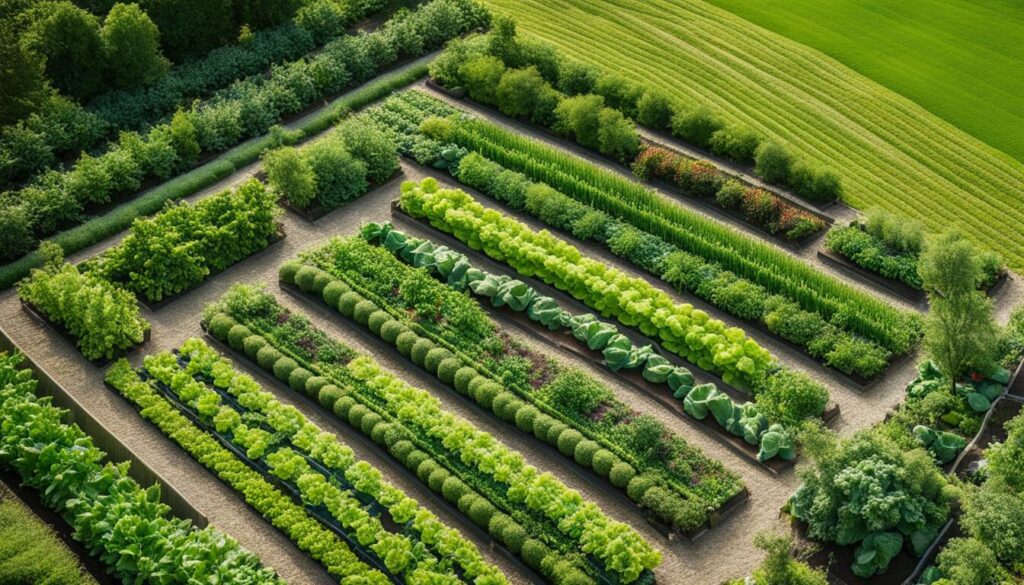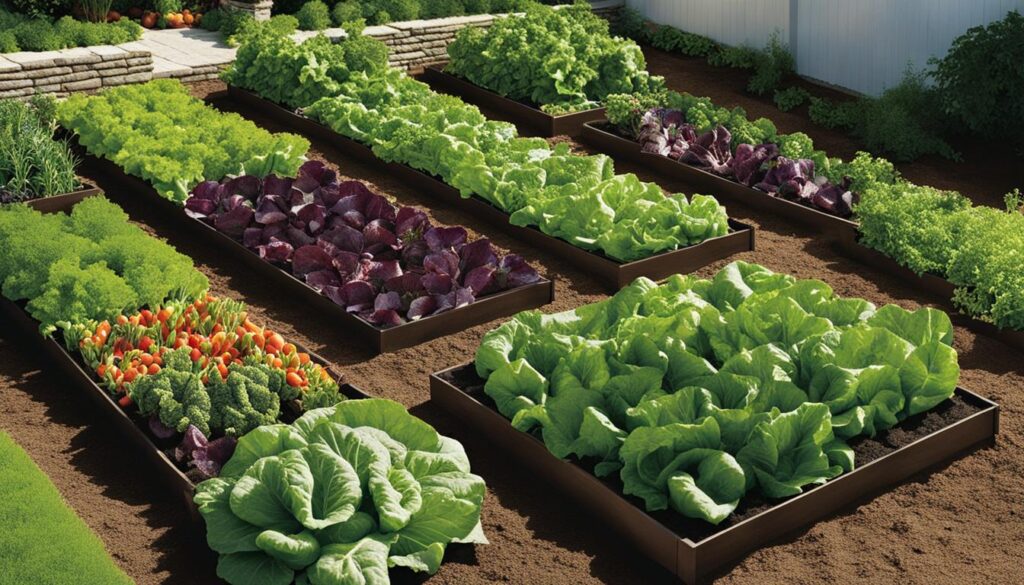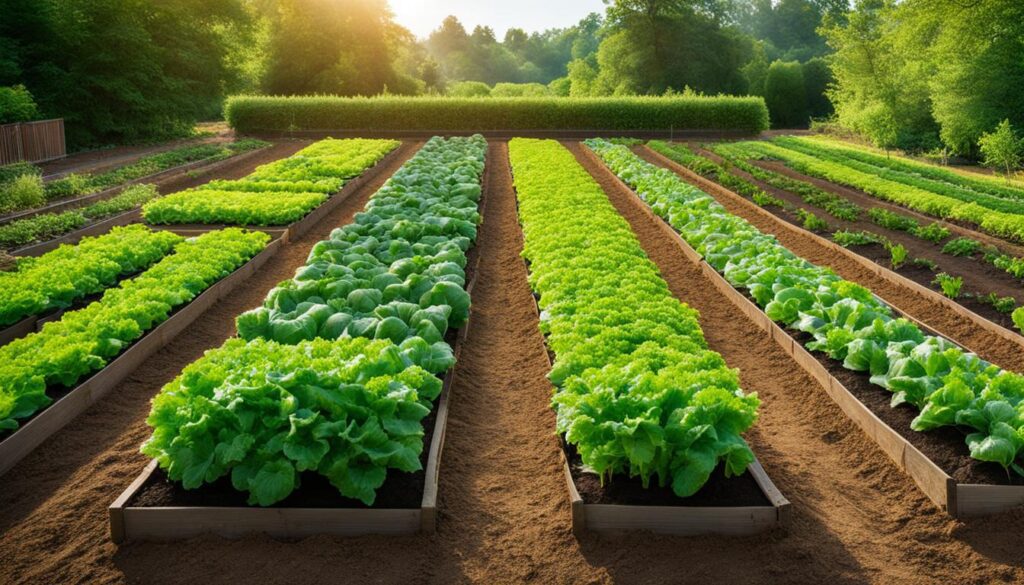Thinking about vegetable garden layout plans and spacing? Whether you have limited space or are new to gardening, proper planning is essential. By knowing the space you have and the requirements of different crops, you can maximize efficiency, space, time, and resources. In this article, we will provide you with super simple vegetable garden layout plans, spacing regulations for planting crops, and steps on how to plan your garden layout effectively.
Key Takeaways:
- Proper planning is essential for maximizing efficiency, space, time, and resources in your vegetable garden.
- Create a map of your property to visualize the available space for your garden.
- Measure out the ideal spots for your garden space to determine the dimensions of your garden rows.
- Consider the sunlight requirements of different crops when planning your garden layout.
- Proper spacing between rows and plants is crucial for efficient garden production.
Make a Map of Your Property
Before you start planning your vegetable garden layout, it’s important to have a clear visual representation of your property. By creating a map, you can identify the available space and determine the best spots for your garden.
Start by using grid paper and colored pencils or pens to draw the major landscape features and buildings on your property. This will provide you with an accurate depiction of your property’s layout. Leave the remaining space on the map for your garden spots.
Once you have your property map, you can start filling in the garden spots with the vegetables you want to plant. Consider factors like sunlight exposure, soil conditions, and drainage when choosing the locations for different crops. This careful planning will help you optimize the use of your garden space and ensure a successful harvest.
Benefits of Creating a Property Map for Your Vegetable Garden Layout
- Allows you to visualize available space
- Helps in identifying ideal garden spots
- Optimizes the use of sunlight and other environmental factors
- Improves the efficiency of your garden layout
- Provides a reference for future planning and expansion
Creating a property map for your vegetable garden layout is an essential step in designing a productive and efficient garden. Take the time to accurately map your property, and you’ll be on your way to growing a flourishing garden filled with fresh and delicious vegetables.
Quote: “By knowing the space you have and the requirements of different crops, you can maximize efficiency, space, time, and resources.” – Gardening Expert
Measure out Ideal Spots for Garden Space
After making a map of your property, it’s time to measure out the ideal spots for your garden space. Taking accurate measurements is crucial for effective vegetable garden layout plans. By knowing the dimensions of your garden space, you can determine how many rows and plants you can accommodate, as well as the spacing between them.
Start by using a tape measure to measure the width and length of your garden rows. Add these measurements to your map, marking them clearly for reference. This will give you a visual representation of your garden space and help you plan the layout more efficiently.
Keep in mind that different crops have specific requirements for garden row width, garden row length, plant spacing, and seed spacing. Refer to gardening resources or seed packets to determine the recommended spacing for each crop. With this information, you can adjust the measurements on your map accordingly, ensuring that your plants have enough room to thrive.
Know What Veggies Require Shade or Full Sun
When planning your vegetable garden layout, it’s important to consider the sunlight requirements of different crops. While all crops need good soil, water, and sunlight, some crops require more sunlight than others. If you have a lot of shade on your property, there are several crops that can grow in partial shade. On the other hand, crops like tomatoes and sweet corn require full sun at all times. Knowing the sun and shade conditions of your property will help you decide where to plant different crops in your garden.
Having a clear understanding of which vegetables prefer shade and which ones need full sun is crucial for successful gardening. Leafy greens like lettuce, spinach, and kale thrive in partial shade, making them perfect choices for areas with limited sunlight. These crops can be strategically placed in spots that receive dappled sunlight throughout the day. On the other hand, heat-loving vegetables like peppers, tomatoes, and cucumbers require full sun for optimal growth and fruit production. These crops should be placed in areas that receive at least 6-8 hours of direct sunlight daily.
Vegetables that can tolerate partial shade:
- Leafy greens (lettuce, spinach, kale)
- Root vegetables (carrots, beets, radishes)
- Herbs (parsley, cilantro, mint)
- Cruciferous vegetables (cauliflower, broccoli, cabbage)
Vegetables that require full sun:
- Solanaceous vegetables (tomatoes, peppers, eggplants)
- Cucurbits (cucumbers, zucchini, melons)
- Legumes (beans, peas)
- Corn
By understanding the sunlight requirements of different vegetables, you can strategically plan your garden layout to ensure each crop has the optimal conditions for growth. This will ultimately result in healthier plants, higher yields, and a more successful gardening experience. Take into consideration the sun exposure in different areas of your garden, and make informed decisions when deciding where to plant shade-loving or sun-loving crops.
Vegetable Garden Row Spacing
When it comes to vegetable garden layout plans, the spacing of rows and plants is crucial for efficient garden production. Proper spacing allows plants to grow to their full potential and minimizes the risk of overcrowding, which can lead to plant diseases and nutrient deficiencies. By following recommended row and plant spacing guidelines, you can ensure optimal growing conditions and maximize your harvest.
The first step in determining row spacing is to consider the dimensions of your garden beds. Measure the width of your beds and leave enough space for walking paths between them. This will not only allow you to move easily through your garden but also provide access for watering, weeding, and harvesting.
Once you have determined the width of your beds, you can then calculate the spacing between rows based on the specific requirements of the crops you plan to grow. Some plants, such as tomatoes and peppers, require more space to spread out, while others, like lettuce and radishes, can be planted closer together. Consult a reliable gardening resource or seed packet for specific recommendations on row spacing for different vegetables.
Within each row, it is also important to consider the spacing between individual plants or seeds. This will depend on the growth habits and size of the mature plants. For example, larger plants like broccoli or cabbage may require more space between each plant, while smaller plants like carrots or spinach can be planted closer together. Again, refer to gardening resources or seed packets for specific guidelines on plant spacing.
Benefits of Proper Row and Plant Spacing:
- Prevents overcrowding and competition for resources
- Reduces the risk of disease and pests
- Allows for better airflow and sunlight penetration
- Facilitates easier access for maintenance and harvesting
- Maximizes efficient use of garden space
Remember, the key to a successful vegetable garden is planning and attention to detail. By ensuring proper row and plant spacing in your garden layout, you can create an environment that promotes healthy plant growth and maximizes your harvest. Take the time to calculate the ideal spacing for each crop, and you’ll be rewarded with a productive and abundant vegetable garden.
The Map Needs Are…
When it comes to planning your vegetable garden layout, having a map of your property is crucial. This map will serve as a visual guide to help you make efficient use of your space and resources. But what do you need to consider when creating this map?
Firstly, you should outline all the major landscape features and buildings on your property. This will give you a clear idea of the available space you have for your garden. Use grid paper and colored pencils or pens to create an accurate representation of your property.
Next, you can start filling in the garden spots on your map. Take into account the width of your garden beds and the spacing requirements for different vegetables. This will help you determine how many plants or seeds you’ll need for each row.
If you’re not confident in your drawing skills, don’t worry. There are garden planning software options available that can assist you in visualizing your garden layout. These tools can provide you with pre-designed templates and make it easy to drag and drop different vegetables onto your map.
Maximize Space + Efficiency + The Perfect Plan = Smarter Gardening
When it comes to vegetable gardening, maximizing space and efficiency is key. By utilizing your available space effectively and having a well-thought-out plan, you can make the most of your garden and maximize your harvest. Planning your vegetable garden layout and spacing is crucial for achieving this goal.
Efficient space utilization is essential in vegetable gardening. By carefully considering the size and requirements of different crops, you can make sure that each plant has enough room to grow and thrive. Proper spacing between rows and plants will help prevent overcrowding, which can lead to poor growth and diseases. By following recommended spacing guidelines, you can ensure that your plants have enough access to sunlight, air, and nutrients.
Aside from space utilization, time management is also important in vegetable gardening. By planning your garden layout in advance, you can save time and effort in the long run. Having a plan in place allows you to organize your garden effectively and streamline your gardening tasks. From planting to maintenance and harvesting, a well-designed garden layout will help you manage your time more efficiently.
Maximizing your harvest is the ultimate goal in vegetable gardening. By following vegetable garden layout plans and spacing recommendations, you can optimize your garden’s productivity. By maximizing space, utilizing your garden efficiently, and having a well-thought-out plan, you can become a smarter gardener and enjoy a bountiful harvest.
With a combination of proper vegetable garden layout plans, space utilization, time management, and efficiency, you can create an ideal environment for your plants to thrive. Planning ahead and considering the specific requirements of each crop will allow you to make the most of your available space and resources. So get ready to reap the rewards of a well-designed vegetable garden and enjoy the fresh, homegrown produce right at your doorstep!
Conclusion
Proper vegetable garden layout plans and spacing are essential for successful gardening. By following these guidelines and considering the specific requirements of different crops, you can design your garden to make the most of your space and resources. Planning ahead, making a map of your property, measuring the ideal spots for your garden, considering sunlight requirements, and determining the spacing of rows and plants are all key steps in creating an optimized garden design.
With an optimal layout, you can achieve space utilization that maximizes your harvest. Whether you have a large plot of land or a small raised bed, proper spacing and organization will help you become a more efficient and successful gardener. By making the most of the available space, you can grow a bountiful garden and enjoy the satisfaction of growing your own food.
So, when planning your vegetable garden, keep in mind the importance of optimal space utilization and a well-designed layout. By implementing these strategies, you can create a garden that not only looks beautiful but also produces an abundance of fresh, homegrown vegetables. Start planning now and get ready to enjoy the fruits of your labor in no time!
How Can I Incorporate Cold Tolerant Vegetables into My Garden Layout?
When planning your garden layout, consider the vegetable cold tolerance_unlocking to maximize your yield. Choose cold-tolerant vegetables like kale, spinach, and lettuce to plant in early spring or late fall. They can withstand chilly temperatures and even enhance their flavor. Incorporating these veggies will extend your growing season and diversify your harvest.
FAQ
What is the importance of vegetable garden layout plans and spacing?
Proper planning ensures efficient utilization of space, time, and resources, leading to maximum productivity in your garden.
How do I make a map of my property for the vegetable garden layout?
Use grid paper and colored pencils or pens to draw all the major landscape and buildings, leaving space for garden spots. This map will serve as a visual guide for your garden.
How do I measure out ideal spots for my garden space?
Use a tape measure to determine the width and length of your garden rows. Add these measurements to your map, allowing you to plan the spacing of different crops between rows and within the rows.
What are the sunlight requirements I should consider for different crops?
Some crops require full sun, while others can grow in partial shade. Knowing the sun and shade conditions of your property will help you decide where to plant different crops in your garden.
How crucial is the spacing of rows and plants in a vegetable garden?
Proper spacing is essential for efficient garden production. Overcrowding can lead to plant diseases and nutrient losses. Knowing the spacing requirements of different crops will help you determine the number of seeds or plants you need to purchase.
Are there any tools available to assist in visualizing the garden layout?
Yes, if you’re not comfortable drawing a map, there are garden planning software options available that can help you visualize your garden layout effectively.
How can I maximize space, efficiency, and have a well-thought-out plan?
By following proper vegetable garden layout plans and spacing guidelines, you can maximize the use of your available space and resources, saving time and ensuring an organized garden for maximum productivity.
What are the benefits of proper vegetable garden layout plans and spacing?
Proper planning and spacing allow you to grow a bountiful garden even in a limited area. It helps you become a smarter gardener and ensures optimal space utilization, leading to a successful harvest.












